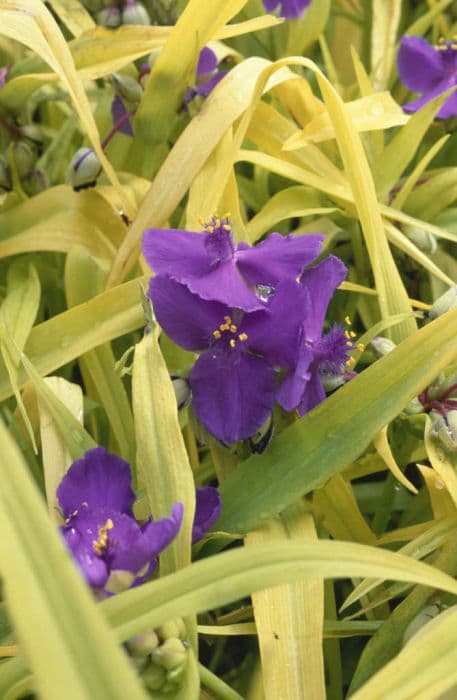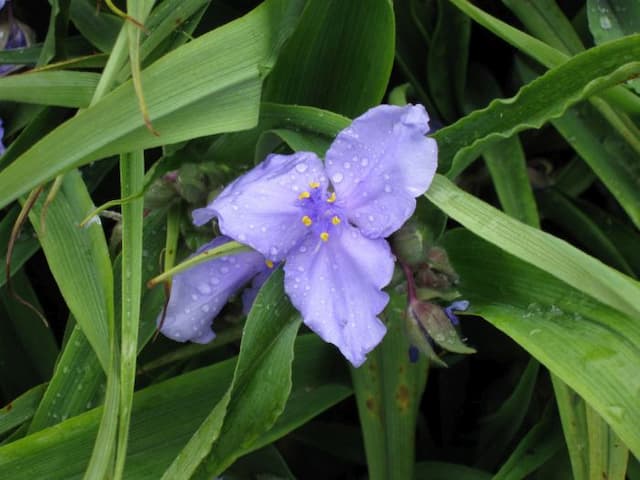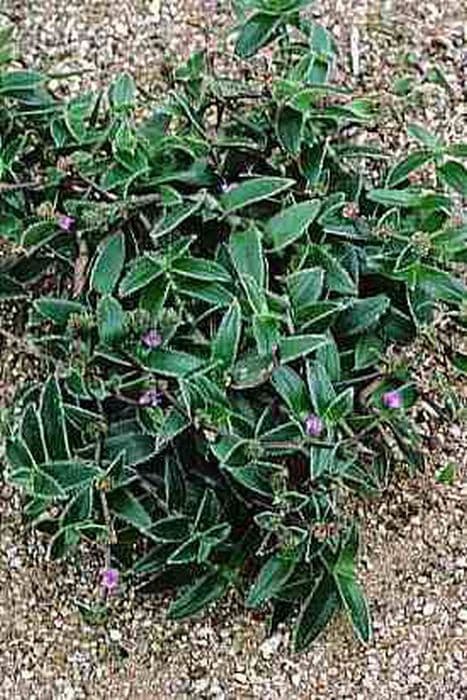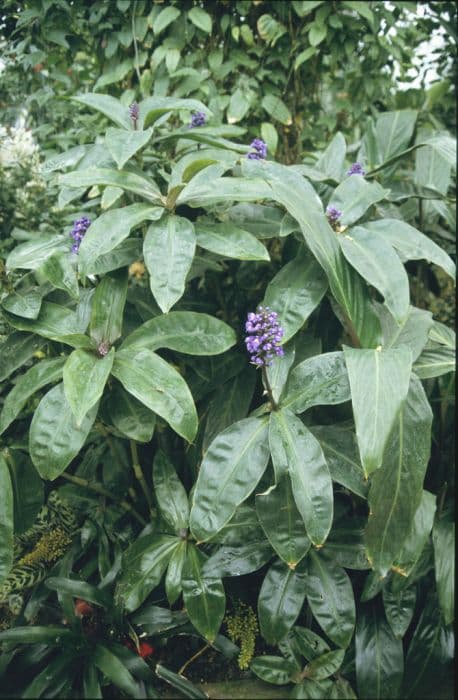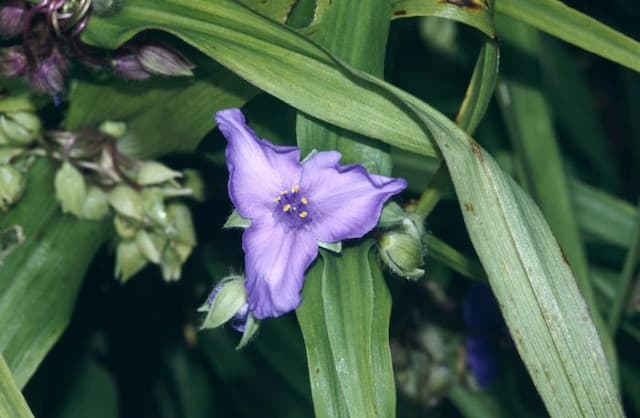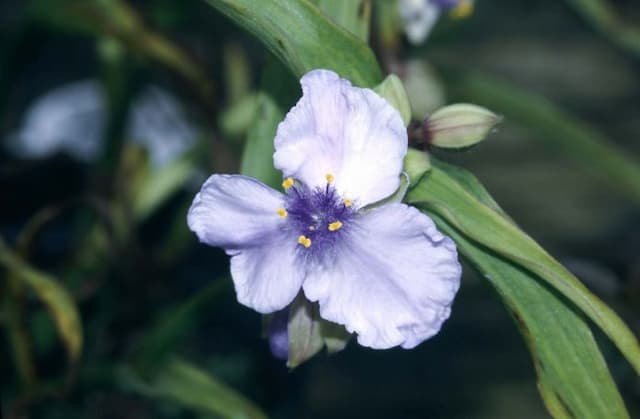Wandering Jew Tradescantia fluminensis 'Maiden's Blush' (v)

ABOUT
Maiden's Blush is a distinctive variety of the popular ornamental houseplant, known for its attractive foliage. The leaves of Maiden's Blush are lance-shaped with a smooth texture and feature a striking coloration that is primarily a bright, creamy white with green variegation and blushes of pink. This pink hue is more pronounced on the younger leaves and tends to fade as they mature, creating a gradient of color. The leaves grow densely along the stems, which cascade or trail elegantly, making it an ideal choice for hanging baskets or raised displays where its foliage can drape naturally. The plant's overall appearance is delicate and graceful, with its variegated leaves creating a soft, pastel display.
About this plant
 Names
NamesSynonyms
Wandering Jew, Inch Plant, Small-leaf Spiderwort, River Spiderwort, Speedy Jenny, Wandering Trad, Wandering Willie
Common names
Tradescantia albiflora, Tradescantia fluminensis Vell.
 Toxicity
ToxicityTo humans
Wandering Jew is non-toxic to humans and generally considered safe. There are no significant toxic effects associated with the ingestion of Wandering Jew plants by humans.
To pets
For pets, Wandering Jew can be mildly toxic. If ingested, it may cause digestive upset, such as vomiting or diarrhea, especially in cats and dogs. It is not typically life-threatening, but ingestion should be avoided, and if symptoms appear, contacting a veterinarian is recommended.
 Characteristics
CharacteristicsLife cycle
Perennials
Foliage type
Evergreen
Color of leaves
Variegated
Flower color
White
Height
6 inches (15 cm)
Spread
1 foot (30 cm)
Plant type
Herb
Hardiness zones
9
Native area
South America
Benefits
 General Benefits
General Benefits- Easy to grow: Tradescantia fluminensis 'Maiden's Blush' is a hardy plant that is relatively easy to care for, making it a good choice for novice gardeners.
- Fast-growing: This plant grows quickly, providing a satisfying experience as you can notice changes and growth frequently.
- Attractive foliage: The plant has attractive variegated leaves with shades of pink, green, and white, adding color and vibrancy to indoor spaces or gardens.
- Versatility: It can be grown both indoors and outdoors, in pots or hanging baskets, making it a versatile addition to various garden designs or home decor themes.
- Groundcover: It's effective as a groundcover due to its dense, mat-forming habit, which can suppress weeds and cover bare spots in gardens.
- Propagation: Tradescantia fluminensis 'Maiden's Blush' is easily propagated from stem cuttings or division, allowing gardeners to create more plants for free.
 Medical Properties
Medical PropertiesThis plant is not used for medical purposes.
 Air-purifying Qualities
Air-purifying QualitiesThis plant is not specifically known for air purifying qualities.
 Other Uses
Other Uses- Photography: The variegated leaves of Wandering Jew 'Maiden's Blush' can add a vibrant, lush backdrop or focus in plant photography due to their distinctive pattern.
- Artistic Inspiration: Artists and designers might use the plant's variegated foliage as inspiration for patterns, textures, and colors in their artwork or fabric designs.
- Crafting: The leaves can be pressed and used in scrapbooking or to adorn hand-made cards, preserving their beauty in a different form.
- Educational Tool: This plant can be used to teach about variegation, plant care, and propagation techniques in a classroom setting or gardening workshop.
- Stress Reduction: Care and tending to a Wandering Jew plant may provide a calming activity for individuals looking for a low-stress hobby or therapeutic pastime.
- Fairy Gardens: Small, delicate leaves of the Wandering Jew can be incorporated into fairy gardens, providing a realistic and enchanting ground cover or backdrop.
- Water Rooting Demonstrations: The ease of rooting Wandering Jew cuttings in water makes it a prime candidate for demonstrations on vegetative propagation and rooting processes.
- Biodegradable Confetti: Small trimmed sections of the variegated leaves can be scattered as biodegradable confetti for eco-friendly celebrations.
- Pet Enrichment: Certain pets, like reptiles and some birds, might appreciate the leaves for interaction or cover, though it's crucial to ensure the plant is non-toxic to the specific pet beforehand.
- Culinary Garnish: While not widely known for culinary use, the attractive leaves could potentially be used as an organic, edible garnish to decorate plates, if confirmed safe for consumption.
Interesting Facts
 Feng Shui
Feng ShuiThe Wandering Jew plant can be used in Feng Shui to bring a sense of growth and fluidity due to its fast-spreading nature. Its lush green leaves with purple accents can help to balance wood and water elements, promoting a flow of positive energy or 'chi'. It’s recommended to place in areas that need an energetic uplift or where you want to encourage movement and change.
 Zodiac Sign Compitability
Zodiac Sign CompitabilityThe Wandering Jew plant is not used in astrology practice.
 Plant Symbolism
Plant Symbolism- Innocence - The 'Maiden's Blush' reflects the notion of purity and naive beauty, in part due to its soft, pastel-colored foliage and its common name that references a 'maiden'.
- Adaptability - Tradescantia fluminensis is known for its ability to thrive in various conditions, symbolizing flexibility and the ability to adjust to different life situations.
- Healing - In folkloric contexts, certain species of Tradescantia are believed to possess medicinal properties, thus representing healing and recovery.
- Growth - The rapid and easy propagation of the plant stands for personal growth and development, as it easily extends and flourishes under the right conditions.
 Water
WaterThe inch plant should be watered about once a week, but always check the top inch of the soil first; if it feels dry, it’s time to water. Use lukewarm water and add enough so that it runs through the drainage holes—this could be approximately 8-16 ounces for a small to medium pot. During the winter months, reduce the frequency to every other week or when the soil is dry to the touch. Be cautious not to overwater as it can lead to root rot, and ensure the pot provides proper drainage.
 Light
LightThe inch plant thrives in brightly lit areas with indirect sunlight. Avoid direct sunlight, especially during the peak hours of the day, as it can scorch the leaves. A north or east-facing window is optimal, providing diffused light that will encourage vibrant foliage without the harshness of direct sun.
 Temperature
TemperatureInch plants prefer a temperature range between 50°F and 80°F, with the ideal conditions being a consistent temperature around 70°F. They can withstand minor fluctuations but should not be exposed to temperatures below 35°F, as cold drafts and frost can severely damage the plant. Keep them away from sources of extreme cold or heat, such as air conditioning units or radiators.
 Pruning
PruningPruning inch plants promotes bushier growth and can prevent them from becoming too leggy. Snip off any long, trailing stems just above a leaf node using clean scissors or pruning shears. Pruning can be done at any time of the year, but it's especially effective during the spring and summer when the plant is actively growing. Generally, pruning every few months or when the plant looks unkempt is sufficient.
 Cleaning
CleaningAs needed
 Soil
SoilThe Wandering Jew 'Maiden's Blush' prefers a well-draining soil mix containing peat, perlite, and compost, with a pH of about 5.0 to 6.5 for optimal growth.
 Repotting
RepottingWandering Jew 'Maiden's Blush' should be repotted once every 1-2 years to replenish nutrients and prevent root crowding.
 Humidity & Misting
Humidity & MistingWandering Jew 'Maiden's Blush' thrives best in moderate to high humidity levels, ideally between 40% and 70%.
 Suitable locations
Suitable locationsIndoor
Place in bright, indirect light and maintain high humidity for Wandering Jew.
Outdoor
Keep in partial shade, protect from harsh sun and ensure soil drains well for Wandering Jew.
Hardiness zone
9-11 USDA
 Life cycle
Life cycleThe life of Tradescantia fluminensis 'Maiden's Blush', commonly known as the Wandering Jew or Inch Plant, starts from seed germination where warmth, light, and moisture trigger the growth of a new plant. After germination, the seedling emerges and establishes a small root system along with its first set of true leaves. As it enters the vegetative stage, the plant experiences rapid growth of stems, leaves, and roots, characterized by its distinctive variegated foliage. The Wandering Jew, being a fast grower, will soon reach maturity, where it is capable of producing small white, pinkish or purple flowers although flowering is not common in indoor environments. The plant can propagate vegetatively with great ease; stem cuttings placed in either water or soil will root rapidly, leading to a new generation of plants. Finally, when environmental conditions are not favorable or in the presence of disease or pests, the plant will decline and eventually die.
 Propogation
PropogationPropogation time
Spring-Summer
Tradescantia fluminensis 'Maiden's Blush', commonly known as the Wandering Jew, is most successfully propagated during the warmer months of spring and summer when the plant is actively growing. The most popular method of propagation for Wandering Jew is through stem cuttings. To propagate, a stem cutting of about 4 to 6 inches (approximately 10 to 15 cm) long is taken, making sure to include at least one leaf node, as this is where the new roots will emerge. The cutting can be placed directly into moist soil or into a glass of water until roots develop, which typically takes about a week. If rooting in water, it's important to change the water every few days to prevent bacterial growth. Once the roots are a few inches long (several centimeters), the cutting can be transplanted into potting soil, where it will continue to grow and eventually become a full-fledged plant.

